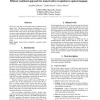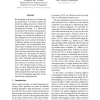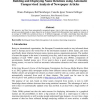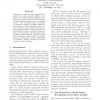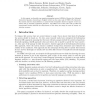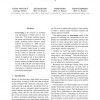JCIT
2010
13 years 11 months ago
2010
The two most important tasks in entity information summarization from the Web are named entity recognition and relation extraction. Little work has been done toward an integrated ...
INTERSPEECH
2010
13 years 11 months ago
2010
We focus in this paper on the named entity recognition task in spoken data. The proposed approach investigates the use of various contexts of the words to improve recognition. Exp...
ICASSP
2010
IEEE
13 years 11 months ago
2010
IEEE
This paper presents a Named Entity Recognition (NER) method dedicated to process speech transcriptions. The main principle behind this method is to collect in an unsupervised way ...
EMNLP
2009
14 years 2 months ago
2009
Bootstrapping is the process of improving the performance of a trained classifier by iteratively adding data that is labeled by the classifier itself to the training set, and retr...
CORR
2006
Springer
14 years 4 months ago
2006
Springer
We present a tool that, from automatically recognised names, tries to infer inter-person relations in order to present associated people on maps. Based on an in-house Named Entity...
ANLP
2000
14 years 6 months ago
2000
This paper describes experiments to establish the performance of a named entity recognition system which builds categorized lists of names from manually annotated training data. N...
RANLP
2003
14 years 6 months ago
2003
In this paper, a system for Named Entity Recognition in the Open domain (NERO) is described. It is concerned with recognition of various types of entity, types that will be approp...
TREC
2001
14 years 6 months ago
2001
In this report, we describe our question-answering system SAIQA-e (System for Advanced Interactive Question Answering in English) which ran the main task of TREC-10's QA-trac...
CLIN
2001
14 years 6 months ago
2001
We describe a Named Entity Recognition system for Dutch that combines gazetteers, handcrafted rules, and machine learning on the basis of seed material. We used gazetteers and a c...
ACL
2003
14 years 6 months ago
2003
Truecasing is the process of restoring case information to badly-cased or noncased text. This paper explores truecasing issues and proposes a statistical, language modeling based ...

